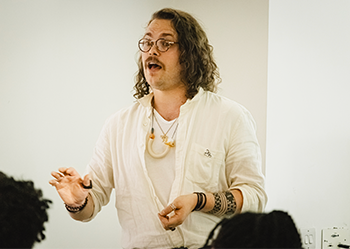University News Last updated 08 May 2024

An architecture expert at Birmingham City University (BCU) is exploring storytelling as a way to capture the silent voices of more-than-human actors and give them a vital stake in architectural planning decisions.
Max Wisotsky, BA Architecture course director at BCU, is focusing on Kiruna/Giron, Sweden’s northernmost city and home to the world’s largest iron mine, in his research Subterranean Feelings: Exploring a more-than-human agency in Northern Sweden.
“I’m exploring ways to communicate the impact of extractionist models of architectural production that don’t just focus on CO2 tonnes or other techno-scientific modelling of the climate crisis,” Max explains.
After more than 120 years of mining operation, the ground beneath large sections of Kiruna/Giron has become unstable and is forcing the city centre to relocate. It's also causing wider impacts on both natural and urban environments.
“When I was up in Kiruna/Giron doing my field study in 2018, I was struck by the fundamental shift in how this landscape was experienced at an emotional level, caused by the change of Kiirunavaara/Gironvárri (the mountain above the mine) from 'the mountain of the ptarmigan' (the Northern Sámi meaning of the name) to this industrial moonscape,” he said.
Max refers to feminist scholar, Donna Haraway who says, “It matters what worlds world worlds”. In this light, he is exploring ways we can tell the story of the “re-worlding” of the mountain and its surrounding landscape, through the voices and experience of both the local indigenous Sámi people, and the non-human and more-than-human neighbours with which they share the land.
“I began to wonder whether the ptarmigan, the mountain, the reindeer, or the river had voices in the planning meetings that decided the next steps. Whether contemporary architectural practice can respond to their needs and develop a model for truly sustainable design,” Max said.
“In my mind, the biggest challenge in getting people to shift their views or consider alternatives to existing practice, lies in the way we communicate the story and who has a right to tell it.
“Research is so often written for other researchers with vast amounts of prior knowledge. I’m interested in how we can evoke more engagement and response from a wider section of those involved, affected, and interested in these large questions around architecture and urbanism.
“For me, this question extends into this modes of storytelling. Exploring critical spatial practices like ‘site writing’ as key methods for architectural research, thinking, and design.
“The ‘subterranean feelings’ referenced in the project title are these site-writing excerpts. A second narrative voice, which uncovers and celebrates the experience of both author and local. It frames the impact of the mine and its infrastructures as problematic techno-scientific solutions of the Capitalocene actively and evocatively.
“This voice and its narrative of unequivocally situated and experiential knowledge are presented as a more honest method for capturing and offering the silent voices of the mountain and her surrounding landscape’s more-than-human citizens.”
As the research continues, Max hopes it will provide opportunities to explore how this way of writing and storytelling, more akin to a poetry reading than an academic conference, can lead to more engagement with students, communities, and our more-than-human neighbours.